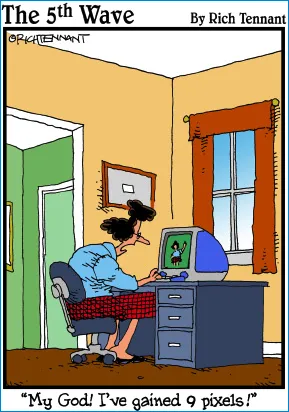Part I
Introducing Portrait Photography
In this part . . .
People have been taking pictures of people since the invention of photography. Photographers have been taking pictures of people on crowded city streets, pictures of friends and family, and pictures that tell you something about a person. And when you capture a person’s essence with a photograph, you have truly taken a portrait of that person.
Many amateur photographers and some professionals think portrait photography is a daunting task, but it doesn’t have to be that way. In this part of the book, I introduce you to the different aspects of portrait photography. In addition, I discuss digital cameras and the settings you should use when shooting a portrait.
1
Exploring Portrait Photography
In This Chapter
Introducing portrait photography
Exploring different types of portrait photography
Creating portraits of friends and family
Portrait photography is fun and can become downright addictive. Armed with a good digital camera and a little or a lot of knowledge, portrait photography gives you the chance to capture a slice of history in a person’s life. When you photograph someone, you’re telling a story. Done right, portrait photography reveals a lot about a person. Whether you’re shooting a formal portrait with a background, photographing someone on location, or capturing a candid portrait, you’re telling your viewers something about your subject. A portrait should be a flattering likeness of your subject, which can be a bit of work. Portrait photography may seem like a daunting task, but it’s extremely rewarding. In this chapter, I show you the various facets of portrait photography and give you an inkling of what’s to come.
Becoming a Portrait Photographer
A portrait is a picture that conveys a likeness of a person, especially his face. When someone views a good portrait of someone they know, the subject is instantly recognizable. When someone views a great portrait of anybody, even a stranger knows something about the subject. A great portrait reveals a person’s character, attitude, outlook on life, and so much more. When you create a portrait, your job is to reveal something about the person you photograph. When someone else looks at the photo and says you really captured the person’s essence, you know you’ve done your job.
Capturing a portrait that reveals more than a person’s physical likeness is easier if you know the person you’re photographing. However, you can still create a great portrait of a relative stranger if you take your time and establish rapport with the person. Creating a compelling portrait is more than just taking a picture. Talking with your subjects will reveal things they’re interested in. When you see the person’s expression change after talking about something they’re interested in, ask a couple of questions about the topic, and then start photographing.
After you engage your subject to bring out her best, another task you must tackle is getting your subject to relax. Unless your subject is a professional model, she’s going to be shy in front of the camera. The smiles may end up looking forced, the facial expressions phony, and so on. It’s like trying to get someone to smile after they’ve received a letter from the IRS telling them to report for a tax audit. Unless you’re shooting candid portraits of people at work or play, a portrait photography session takes time. As a portrait photographer, you must slow down, relax, and take your time. Give your subject the time she deserves. If your subject can’t seem to relax and is preoccupied with other thoughts, reschedule the shoot at a time that’s convenient for your subject.
Your job as a portrait photography is twofold: getting your subject to put on a happy face and knowing how to capture that happy face digitally for posterity. To do those things, you must get to know your equipment — know how to light your subject, choose the right camera settings, and so on.
Your first foray into portrait photography may be an outright disaster. If you’re not familiar with your equipment, you won’t be able to devote time to your subject. If you spend too much time fiddling with your equipment, your subject will quickly lose interest, and you won’t be able to capture a natural portrait. Let’s face it, some people need to be the center of attention, and this is especially true when you’re capturing a portrait of a person. Be prepared ahead of time, and your photo shoot will flow.
If you’re shooting a formal portrait, always set up your equipment and backdrop before your subject arrives.
Photographing Friends and Family
Photographing people you know and love may seem like a piece of cake, but sometimes knowing the people you’re photographing makes the job harder. They may trivialize your interest in photography. They may look at you and think, “There he is with the camera again.” This is when you need to take control and let your subjects know that you’re a serious photographer, and your goal is to make them look their best. In these situations, you end up being coach, cheerleader, and task master.
Anybody can take a picture of a person. All you need to do is grab a camera, point it at the person, click the shutter, and you’ve got the shot. (Hmmm . . . guess that’s why some digital cameras are called point-and-shoot.) The way to get a good portrait is to find a great location, use the proper equipment with the right settings, and work with your subject(s). You’re the artist. You’ll have to tell your subject how to pose, tilt her head, and get her to put her best face forward. Natural smiles are a good thing. Forced grimaces do not make good portraits. When you’re shooting a portrait of a person on location, you need to pick the best area based on the scenery and available lighting. This may involve taking lots of pictures to get a few good ones. But that’s the beauty of digital photography. You can see what you’ve got on the LCD monitor and know whether you’ve captured the quintessential portrait of your subject or a picture that’s a candidate for the trash bin.
If you’re shooting a formal portrait of someone you know, you need to set up the shot, arrange the lighting, and choose the proper camera settings. In addition, you need to tell your subject what to do, pose him in a pleasing manner, and then put him at ease. Yes, it is a daunting task. That’s why the pros get big bucks for creating professional portraits.
Relax your subject and get her to laugh by telling her that the area in front of your camera is a “No Blink” zone.
When you decide to pursue portrait photography seriously, let your friends and family know your goals. They’ll be more supportive and won’t think you’re being a nuisance when you ask to take their pictures. In exchange for a portrait session, tell your subject he’ll get an 8 x 10 print of his favorite picture from the shoot. You can get quality prints from online printing companies such as Mpix and Shutterfly. Another good idea is to create a small photo book of your best shots. Then when a photogenic family moves into the neighborhood, you can introduce yourself as the neighborhood portrait photographer. You can also use your brag book at parties and social functions. When you show people a photo book of your best work, they’ll know you’re a serious photographer. Sweeten the deal with a free print and you’ve got another subject. I carry a 4-x-4-inch book of my portrait work with me at all times. Showing it to friends and colleagues has resulted in many interesting photo opportunities. For online printing and photo book resources, see Chapter 15.
Your best shots generally come at the end of a session. Let your subject know ahead of time how long your session will run. As the session moves to a conclusion, your subject will become more comfortable in front of the camera.
Creating candid portraits
Candid portraits are wonderful. You capture people doing what they do best, having fun or just being themselves. When you shoot candid portraits, you’re like a fly on the wall. You’ve got the camera ready to go with all the right settings dialed in. Then when you see your subject doing something interesting, compose your picture, click the shutter button, and you’ve got an interesting photo.
You can create a candid portrait anywhere. If it’s your nephew’s first birthday party, make sure you’ve got your camera ready when he gets a piece of his birthday cake. You’ll end up with wonderful portraits of a laughing child with a mouthful of cake, frosting-streaked hair, and gooey fingers. Remember to capture a photo of the tyke’s parents hosing him off after the party. When the child grows older, his parents will appreciate the portrait, and the now-grown child may be interested in it — or embarrassed ...










